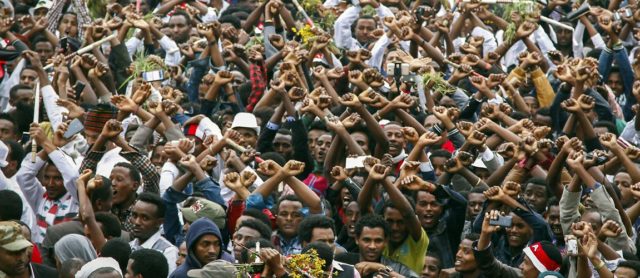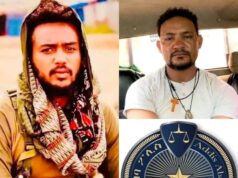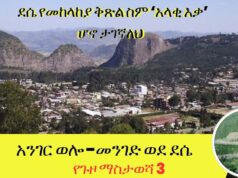
by Margaux Pinard and Clionadh Raleigh
Ethiopia has experienced an unprecedented wave of popular mobilization since November 2015. The government responded to the protests with a heavy hand, resulting in thousands of casualties and tens of thousands of people being arrested and charged with terrorism offenses. Available data collected from international and local media points to more than 1,200 people reported killed during the protests. A state of emergency has been extended into July 2017. Further, militant activity has risen in tandem with popular unrest, stemming from both the distraction that civil unrest posed for the Ethiopian military, and also shared grievances..
The protests in the Oromia region are generally seen as part of a movement that began in April-May 2014. At the time, students across several locations protested a plan to expand the capital, Addis Ababa, by approximately 1.1 million hectares into Oromia territories (hereafter, the Addis Ababa Master Plan). This expansion aimed to accommodate the demands for residential, commercial, and industrial properties by a growing middle class in the capital as a result of an economic boom. The 2014 protests, led by university students, were comparatively small and situated in the Western part of Oromia (see figure 1). Demonstrations resumed in November 2015 in Ginci over the sale of the stadium and clearing of the local forest for the proposed expansion. They were mainly led by students from secondary schools and universities. They quickly gained momentum and the students were soon joined by farmers, workers, and other citizens.
The Oromos’ response to the publication of the Addis Ababa Master Plan highlighted the fundamental tension between the state’s centralized development strategy and non-Tigrayan ethnic groups’ desire for more public consultation and localized decision-making in the face of economic marginalization and dispossession.
The Master Plan was published in 2014 without meaningful consultations with the impacted communities. It raised concerns among many Oromos about adequate compensation and protections to households that would face evictions. Similar forceful evictions had already occurred in the past in Oromia, linked to the government’s promotion of private sector agricultural investments since 2005.
The plan was also perceived as violating constitutionally enshrined territorial rights attributed to the region. Finally, it came against the backdrop of social tensions fed by sentiments of economic marginalization, particularly among non-Tigrayan people. Strong economic growth in Ethiopia is accompanied by growing inequalities. The economic gap between rich and poor appears to be widening. In parallel, unemployment and underemployment have risen, particularly among educated youth in urban areas, and allegations of public corruption have spread.
Considering the centralized economic growth strategy, populations have suspected the Tigrayan elite—which has dominated the government since the Ethiopian People’s Revolutionary Democratic Front (EPRDF) coalition came to power in 1991—of being the main beneficiary of the economic boom. In December 2015 and on several occasions in 2016, riots targeted local business and development projects in Oromia, notably related to flower production, mining, light manufacturing, and tourism, revealing a deep resentment of the government’s program of development and resource distribution.
The Ethiopian government suspended the Addis Ababa Master Plan as a concession to the protesters in early January 2016. However, the protests continued and spread. In February 2016, there was still an average of 26 per week. While the number sharply dropped to seven per week between March and April 2016 due to the onset of the sowing season, large-scale demonstrations resumed in May 2016 and continued over the summer. Fresh protests also occurred in the Amhara region from the end of July 2016. The continuation of the protests revealed widespread suspicion of the regime and enduring grievances among different ethnic groups, particularly in the way federalism is implemented, and in the way power is shared.
First, the dominance of the Tigrayan Peoples’ Liberation Front (TPLF) within the EPRDF means that other involved parties in the ruling coalition lost their status as legitimate representatives of the ethnic groups they nominally represent. Oromo dissenters, for instance, widely perceive their EDPRF representatives as “government puppets,” handpicked by the TPLF. The Oromo community represent around 30% of the Ethiopian population (approximately 30 million people). TPLF represents the Tigrayan ethnic group, which comprises 6% of Ethiopia’s 100 million population.
From the onset, the TPLF has sought to play a leading role in defining the country’s political trajectory. TPLF Chairman Meles Zenawi ruled Ethiopia from 1995 until his death in 2012. Zenawi’s control of government representatives tightened after the war with Eritrea (1998-2000), leading to a concentration of political power in an increasingly smaller number of politicians close to him. When Hailemariam Desalegn replaced Zenawi as prime minister in 2012, the TPLF elite adopted measures to cripple the new prime minister’s power. Among other things, they reduced Desalegn’s control over ministries and retained control of key defense, intelligence, and foreign affairs posts. The nationalists among the Amhara also resent TPLF’s domination in government affairs. They have long accused the party of taking several areas between the Tigray and Amhara regions out of Amharas’ control when drawing the ethnic boundaries in the 1990s, such as the Wolkayt district.
Second, the government’s maintaining of tight control over the regions and the localities eliminates the possibility of regional representatives enacting their constitutional rights of autonomy or secession. The Oromo community generally support ethnic federalism, but aspire to greater autonomy, and resent government intrusion in regional affairs. The EPRDF retains power through a number of key methods: by controlling the establishment of representatives and policies of regional parties; by controlling access to regions and districts’ resources and thus rendering them heavily dependent on federal budget transfers; by denying private landholdings and land tenure security in rural areas, making the welfare of local communities’ dependent on their relations with local officials, whom control access to resources; and by having the right to deploy federal police and armed forces whenever it deems a crisis to be exceeding a region’s capacities.
Thirdly, since its arrival in power, the EPRDF has controlled the political trajectory of the country and displayed an authoritarian mode of governance. The EPRDF secured an absolute majority in regional and national elections in 1995 and 2000 (see Figure 2). The elections in 2005 were a turning point, as the EPRDF was confronted for the first time with a real opposition. One of the opposition parties, the Coalition for Unity and Democracy (CUD), rejected the declaration of the EPRDF as winner of the polls and called upon its sympathizers to engage in civil disobedience. Authorities heavily repressed the demonstrations that followed, leaving around 200 people killed and thousands detained.
The government blamed the revolt in 2005 on having been too liberal. As a result, the following decade saw no new democratic reforms, an expansion of surveillance, and an expansion of the localization of government decisions. There were regular reports of threats to, and detention and prosecution of, opposition party members, activists, bloggers, journalists, and academics, often without charge. The government also used anti-terrorism laws, passed to assist the Western-based “war against terror” to criminalize and prosecute any expression of dissent, particularly in Oromia, which had active insurgency movements. Between 2011 and 2014, at least 5,000 Oromos were arrested as a result of their actual or alleged peaceful opposition to the government.
The lack of genuine central representation of all ethnic groups and the dominance of the ruling party within the security sector, local government, and legislative politics means that avenues for political opposition or dissent are practically non-existent. The Ethiopian government’s unrelenting use of lethal force against largely peaceful protesters since November 2015 has played a major role in bolstering a shared sense of grievance among the Oromo and other ethnic groups.
Protests in Oromia have been largely peaceful gatherings of collective marches, boycotts and strikes. One of the protesters’ major campaigns was the organization of a “grand protest” against the government agenda across 200 cities in Oromia on August 6, 2016. Riots often occurred in reaction to prior state violence against protesters in the same areas. Riots in Oromia particularly escalated following government violence at the Irecha festival in Bishoftu (West Shewa) on October 2, 2016. Oromo activists called the escalation the “week of rage,” as protesters in different parts of the region blocked roads and attacked local administration buildings, police stations, and businesses built on lands allegedly confiscated from local Oromo control.
The Amhara community joined the Oromo protests in August 2016, after a fatal clash between security forces and Amhara residents over the Wolkayt issue ignited regionalist grievances. Amhara protesters displayed an unprecedented level of solidarity with the Oromos, organizing joint marches, sit-ins, boycotts, and stay-at-home protests, as well as using other non-violent tactics, such as head shaving and crossing arms above the head. Long-standing historical tensions, as well as differing political agendas had previously prevented similar forms of union between the two groups.
The government’s violent response to the Oromo protests also prompted populations in other regions to demonstrate their solidarity with the Oromo protesters or to be more vocal about their own grievances; this is the case for the Konso, Quemant, and Surma communities, for instance.
From the onset, the government has accused the protest movement of being infiltrated by rebel groups, such as the Oromo Liberation Front (OLF) and the Patriotic Ginbot 7 for Unity and Democratic Movement (AGUDM). The government considers these groups to be terrorist organizations supported by external forces, including Eritrea and Egypt. The label has been used to discredit the protesters and justify the deployment of the Anti-Terror Task Force to the region, starting on December 15, 2015.
The government’s crackdown on the protests continued after the suspension of the Master Plan, as protests continued and spread. Among other measures, the government deployed federal military units throughout the stricken regions; implemented security structures meant to spy on, expose, imprison and kill dissidents; and increased its surveillance and censorship powers on digital platforms, while curbing civil society activity. Finally, by declaring an unprecedented state of emergency on October 8, 2016, the government cemented its commitment to repression rather than dialogue.
Available data collected from international and local media since November 2015 points to more than 1,200 people reported killed during protests (see Figure 3). Approximately 660 fatalities are from state violence against peaceful protesters, 250 from state engagement against rioters, and more than 380 people were killed by security forces following the declaration of the state of emergency in October 2016. This compares to 842 deaths acknowledged by the government-appointed Ethiopian Human Rights Commission (EHRC) in unrest across Oromia and other regions since November 2015. Tens of thousands of people have also been arrested and charged with terrorism offenses, including 20,000 in the months that followed the declaration of the state of emergency.
The state of emergency imposed tight restrictions that have since successfully curbed the protests. However, significant developments have occurred in parallel, pointing to persisting discontent in Ethiopia.
First, the significant reduction in riots and protests accompanied an increase in political and ethnic militia activity, and in battles involving security forces and foreign-based rebel groups (see Figure 4). The ACLED dataset shows that rebel activity in 2016 was at its third-highest since 1997. Rebellion reached unprecedented levels in Oromia and Tigray, led by the OLF and the AGUDM forces respectively; and in Amhara, rebellion led by the AGUDM forces resurged after two years of inactivity. The scale and spread of the protests has encouraged rebel groups and opposition movements to gather their forces into a single front against the current government, in a manner reminiscent of the overthrow of previous Ethiopian regimes. In parallel, unidentified armed groups have become increasingly active in Amhara, engaging in various clashes with state forces and executing no less than 13 bomb and grenades attacks, mainly targeting state officials, between January and April 2017. Finally, since the beginning of 2017, large numbers of the Oromo community have risen up against a marked increase in attacks and human rights violations in Oromia by state and paramilitary forces, such as the Liyu police. Data collected shows at least 40 clashes between the two parties between January and May 2017 resulting in around 160 fatalities. This compares to only six clashes during the protest period. The Oromo community identifies the increased activity by the Liyu police as a way for the government to usurp Oromo lands and further quash dissent. The government’s assignment of federal soldiers to all members of the Oromia regional police after suspecting some of them of supporting Oromo militias in the recent clashes, revealed its continued control of the country’s security apparatus. Though the link between the protesters and the various armed groups remains unclear, these trends point to an escalation from peaceful unrest to an armed struggle taken up by local armed militias and rebel movements united in their aim to remove the government.
Secondly, grievances that motivated the protests of the past two years have not been addressed, and discussions have yet to take place between the government and the protesters. Some small-scale, punctual protests continue to occur. In Oromia, people protested in March 2017 against violence by the Liyu police and the continued arrest and detention of political prisoners. In Amhara, people protested against the planned demolition of thousands of houses by the government. Finally, at various international sporting events in early 2017, several Ethiopian athletes have protested EPRDF’s inability to embrace ethnic and religious diversity, by refusing to wave the current Ethiopian flag to celebrate their victories. These trends point to a probable resumption of protests once the state of emergency is lifted.
Margaux Pinard is a Research Analyst at the Armed Conflict Location and Event Data Project (ACLED). Clionadh Raleigh is Director of ACLED.























